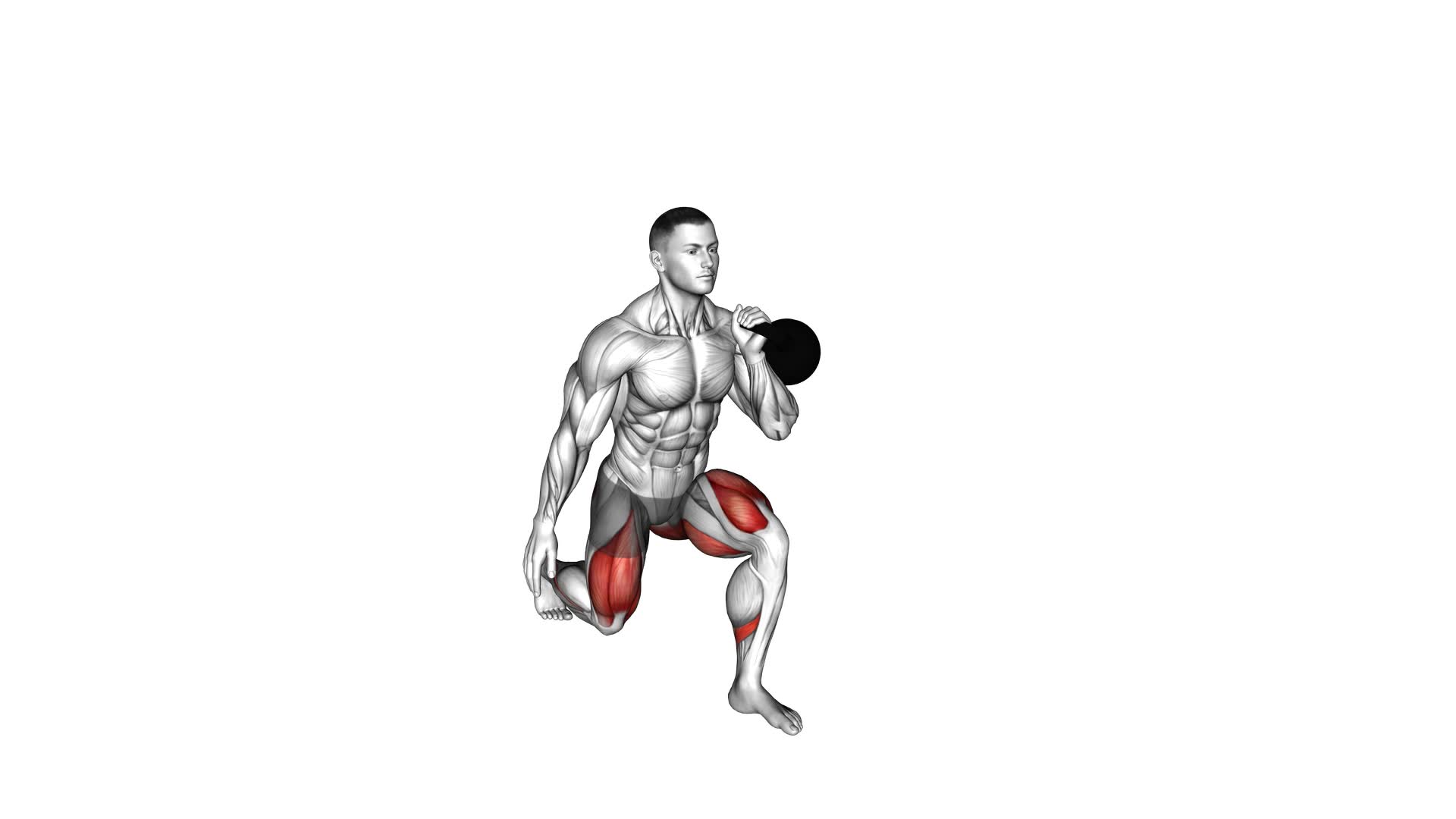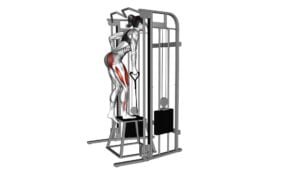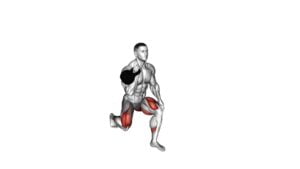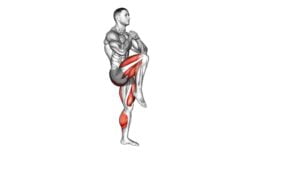Kettlebell Ipsilateral Reverse Lunge (male) – Video Exercise Guide & Tips

Looking to level up your leg workout? Check out this video exercise guide for the kettlebell ipsilateral reverse lunge.
Watch This Exercise Video
With step-by-step instructions and helpful tips, you'll learn the proper form and technique for this challenging exercise.
Whether you're a beginner or an experienced lifter, this exercise can help improve your balance, stability, and lower body strength.
Get ready to feel the burn and take your leg training to the next level.
Let's dive in!
Key Takeaways
- Increased stability and strength in lower body
- Targets glutes, hamstrings, quads, and calves
- Activates muscles on same side of body for balance and coordination
- Improves unilateral leg strength
Benefits of the Ipsilateral Reverse Lunge
You'll experience increased stability and strength in your lower body with the ipsilateral reverse lunge. This variation of the lunge exercise is highly beneficial for targeting your glutes, hamstrings, quads, and calves. By stepping back with the same leg as the hand holding the kettlebell, you activate the muscles on the same side of your body, promoting better balance and coordination.
One of the key benefits of the ipsilateral reverse lunge is its ability to improve unilateral leg strength. Since each leg is working independently, any imbalances in strength or stability can be identified and corrected. This helps to prevent injuries and improves overall athletic performance.
In addition, the ipsilateral reverse lunge also enhances hip mobility and flexibility. By stepping back into a deep lunge position, you stretch the hip flexors and increase range of motion in the hips. This is particularly beneficial for activities that require hip mobility, such as running, jumping, and squatting.
To add variety to your workout routine, there are several variations of the ipsilateral reverse lunge you can try. You can perform it with different types of kettlebells, such as a single arm kettlebell or a double kettlebell. You can also incorporate other equipment like resistance bands or medicine balls to increase the challenge.
Proper Form and Technique
When performing the kettlebell ipsilateral reverse lunge, it's important to focus on hip and knee alignment to avoid straining the joints.
You should also engage your core for stability throughout the exercise to maintain balance and control.
Additionally, proper breathing technique, such as exhaling during the lunge and inhaling on the return, can help optimize your performance.
Hip and Knee Alignment
To maintain proper form and technique during the kettlebell ipsilateral reverse lunge exercise, consistently focus on aligning your hips and knees. Proper alignment of these joints is crucial for hip mobility and injury prevention.
When performing the lunge, make sure your front knee is directly above your ankle, forming a 90-degree angle. Your back knee should be bent, but avoid letting it touch the ground. Keep your hips level throughout the movement and avoid any excessive forward or backward tilting.
Engage your core to stabilize your body and maintain balance. By aligning your hips and knees, you ensure that the right muscles are engaged and reduce the risk of strain or injury.
Core Stability Importance
Maintain proper form and technique during the kettlebell ipsilateral reverse lunge exercise by prioritizing core stability, which is crucial for overall balance and injury prevention.
To improve your core stability, incorporate these core stability exercises into your routine:
- Plank: Start by lying face down, then raise your body off the ground using your forearms and toes. Keep your body in a straight line from head to toe, engaging your core muscles.
- Russian twists: Sit on the ground with your knees bent and feet off the floor. Hold a weight or medicine ball in your hands and twist your torso from side to side, engaging your core muscles.
- Dead bug: Lie on your back with your arms extended towards the ceiling. Raise your legs and bend your knees at a 90-degree angle. Extend one leg while simultaneously lowering the opposite arm towards the floor. Switch sides and repeat.
- Bird dogs: Start on all fours with your hands directly under your shoulders and knees under your hips. Extend one arm forward while simultaneously extending the opposite leg backward. Switch sides and repeat.
By incorporating these core stability exercises into your core strength training routine, you'll develop a strong and stable core, which is essential for maintaining proper form and technique during the kettlebell ipsilateral reverse lunge exercise.
Transitioning into the next section, let's now discuss the importance of breathing technique during exercise.
Breathing Technique During Exercise
As you prioritize core stability during the kettlebell ipsilateral reverse lunge exercise, it's crucial to focus on your breathing technique for proper form and technique. Proper breathing techniques play a significant role in maximizing the benefits of your workout.
When performing the kettlebell ipsilateral reverse lunge, inhale deeply through your nose before initiating the movement. As you step back into the lunge, exhale forcefully through your mouth. This exhale helps engage your core and stabilize your body throughout the exercise. By coordinating your breath with the movement, you enhance your overall stability and control, allowing you to execute the exercise more efficiently.
Now that you understand the importance of proper breathing, let's move on to discussing the equipment needed for this exercise.
Equipment Needed for the Exercise
You will need a kettlebell for this exercise. Here are four recommended pieces of equipment to enhance your workout:
- Kettlebell: The primary equipment needed for this exercise is a kettlebell. Choose a weight that challenges you but allows you to maintain proper form throughout the movement.
- Exercise Mat: Using an exercise mat can provide cushioning and support for your knees and joints during the lunges. It can also help prevent slipping or sliding on smooth surfaces.
- Comfortable Athletic Shoes: Wearing proper footwear is essential for stability and support during the exercise. Opt for athletic shoes that provide good traction and fit well to avoid any discomfort or injuries.
- Water Bottle: Staying hydrated is crucial during any workout routine. Make sure to have a water bottle nearby to sip on during breaks and stay hydrated throughout the session.
By having the right equipment, you can ensure a safe and effective workout.
Now, let's move on to the next section, where we'll discuss common mistakes to avoid during the kettlebell ipsilateral reverse lunge exercise.
Common Mistakes to Avoid
When performing the kettlebell ipsilateral reverse lunge, it's important to avoid common mistakes that can hinder your progress and potentially lead to injury.
One common mistake is imbalanced weight distribution, where you place more weight on one side than the other, compromising your form.
Another mistake to avoid is foot placement errors, such as stepping too far forward or backward, which can affect your stability and control.
Lastly, lack of core stability can also be a common mistake, as it's important to engage your core muscles throughout the exercise to maintain proper alignment and balance.
Imbalanced Weight Distribution
The article warns against the common mistake of imbalanced weight distribution when performing the kettlebell ipsilateral reverse lunge. It's crucial to maintain proper weight distribution throughout the exercise to avoid injury and maximize the effectiveness of the movement.
Here are four tips to help you correct imbalances in weight distribution:
- Focus on keeping an equal amount of weight on both feet.
- Engage your core and maintain a strong, stable center of gravity.
- Pay attention to your body alignment and ensure your hips, knees, and ankles are properly aligned.
- Practice with lighter weights initially to develop balance and control before progressing to heavier loads.
By following these tips, you can correct weight imbalances and perform the kettlebell ipsilateral reverse lunge safely and effectively.
Now, let's move on to the next section, where we'll discuss common foot placement errors.
Foot Placement Errors
To ensure proper weight distribution and avoid imbalances, it's important to pay attention to your foot placement when performing the kettlebell ipsilateral reverse lunge.
Common errors in foot placement can lead to decreased stability and increased risk of injury. One mistake to avoid is placing too much weight on the toes, which can cause excessive pressure on the knees and lead to instability. Another error is allowing the knees to collapse inward, which can put stress on the joints and hinder proper alignment.
To correct these mistakes, focus on keeping your weight evenly distributed between your heel and the ball of your foot. Additionally, engage your core muscles and actively push your knee outwards to maintain proper alignment.
Lack of Core Stability
Improve your core stability by avoiding common mistakes. Here are four key tips to enhance your core strength during the Kettlebell Ipsilateral Reverse Lunge exercise:
- Engage your core muscles: Focus on contracting your abdominal muscles throughout the movement to maintain stability and control.
- Maintain proper posture: Keep your spine aligned and avoid leaning forward or arching your back. This will help distribute the load evenly and prevent unnecessary strain on your core.
- Control your movements: Slow and controlled movements are essential for activating your core muscles effectively. Avoid rushing through the exercise to ensure proper engagement.
- Incorporate balance training: Performing exercises that challenge your balance, such as single-leg exercises or using unstable surfaces, can further enhance your core stability.
By implementing these tips, you can maximize the benefits of the Kettlebell Ipsilateral Reverse Lunge and develop a stronger core.
Modifications and Progressions
Level up your kettlebell ipsilateral reverse lunges with these modifications and progressions.
If you're looking to challenge yourself and take your workout to the next level, try incorporating some progressions into your routine. One modification you can make is to increase the weight of the kettlebell. This will add more resistance and make the exercise more challenging for your legs and core.
Another modification is to perform the lunges on an unstable surface, such as a balance board or a Bosu ball. This will require more stability and engage your core muscles even more.
To progress the exercise, you can try adding a plyometric element. Instead of stepping back into the lunge, explode off the ground and switch legs mid-air. This will elevate your heart rate and add a cardio component to the exercise.
Another progression is to perform the lunges with a rotational twist. As you step back into the lunge, rotate your torso towards the side of the leg that's stepping back. This will engage your obliques and add an extra challenge for your core.
Now that you know some modifications and progressions, let's move on to the next section where we'll discuss some tips for incorporating the kettlebell ipsilateral reverse lunge into your workout routine.
Tips for Incorporating the Exercise Into Your Workout Routine
To effectively incorporate the kettlebell ipsilateral reverse lunge into your workout routine, focus on maintaining proper form and gradually increasing the intensity. Here are four tips to help you incorporate this exercise into your workouts:
- Start with lighter weights: If you're new to kettlebell training or the ipsilateral reverse lunge, it's important to start with lighter weights. This will allow you to focus on proper form and technique before gradually increasing the weight.
- Incorporate modifications: As you become more comfortable with the exercise, you can incorporate modifications to challenge your muscles in different ways. For example, you can try holding the kettlebell in a different position, such as a goblet hold or a farmer's carry position.
- Add it to your leg day routine: The kettlebell ipsilateral reverse lunge is a great exercise for targeting your glutes, hamstrings, and quadriceps. Consider adding it to your leg day routine to strengthen these muscles and improve your overall lower body strength.
- Combine it with other exercises: To keep your workouts interesting and to work multiple muscle groups, consider combining the kettlebell ipsilateral reverse lunge with other exercises. For example, you can pair it with kettlebell swings or kettlebell deadlifts to create a full-body workout.
Frequently Asked Questions
How Many Calories Can I Expect to Burn by Doing the Kettlebell Ipsilateral Reverse Lunge?
You can expect to burn a significant amount of calories by doing the kettlebell ipsilateral reverse lunge.
This exercise engages multiple muscle groups, including the legs, glutes, and core, which leads to increased calorie burning.
Additionally, the added resistance from the kettlebell enhances muscle activation and further boosts calorie expenditure.
Incorporating the kettlebell ipsilateral reverse lunge into your workout routine can be an effective way to burn calories and improve overall strength and stability.
Can the Kettlebell Ipsilateral Reverse Lunge Help Improve My Balance and Stability?
Yes, the kettlebell ipsilateral reverse lunge can definitely help improve your balance and enhance stability.
By engaging your core muscles and challenging your coordination, this exercise forces you to maintain control and stability throughout the movement.
The unilateral nature of the lunge also helps to address any muscle imbalances and promotes equal strength and stability on both sides of your body.
Incorporating this exercise into your routine can greatly benefit your overall balance and stability.
Is the Kettlebell Ipsilateral Reverse Lunge Suitable for Beginners?
The kettlebell ipsilateral reverse lunge is a great exercise for beginners. It helps improve your balance and stability while working your lower body muscles. If you're new to this exercise, there are modifications you can make to make it easier.
Start by using a lighter kettlebell or even just your body weight. As you get stronger, you can gradually increase the weight.
How Often Should I Incorporate the Kettlebell Ipsilateral Reverse Lunge Into My Workout Routine?
To determine the optimal frequency for incorporating the kettlebell ipsilateral reverse lunge into your workout routine, consider factors like your fitness level and goals. Gradually increase the frequency as you become more comfortable with the exercise.
Start with 2-3 times per week and monitor your progress.
As for the weight, choose one that challenges you but allows you to maintain proper form throughout the movement.
Consulting with a fitness professional can help you determine the best weight for you.
Can the Kettlebell Ipsilateral Reverse Lunge Help Strengthen My Glutes and Hamstrings?
The kettlebell ipsilateral reverse lunge is a great exercise for improving glute and hamstring strength. It targets these muscles while also engaging your core and balancing skills.
Kettlebell exercises are known for their benefits in strengthening the lower body, and this exercise is no exception.
Conclusion
In conclusion, the kettlebell ipsilateral reverse lunge is a highly effective exercise for building strength and stability in the lower body.
By incorporating proper form and technique, you can enhance your workout routine and reap the benefits of this exercise.
Remember to avoid common mistakes and make any necessary modifications or progressions to suit your fitness level.
Add this exercise to your routine and watch your lower body strength and stability improve.

Author
Years ago, the spark of my life’s passion ignited in my mind the moment I stepped into the local gym for the first time. The inaugural bead of perspiration, the initial endeavor, the very first surge of endorphins, and a sense of pride that washed over me post-workout marked the beginning of my deep-seated interest in strength sports, fitness, and sports nutrition. This very curiosity blossomed rapidly into a profound fascination, propelling me to earn a Master’s degree in Physical Education from the Academy of Physical Education in Krakow, followed by a Sports Manager diploma from the Jagiellonian University. My journey of growth led me to gain more specialized qualifications, such as being a certified personal trainer with a focus on sports dietetics, a lifeguard, and an instructor for wellness and corrective gymnastics. Theoretical knowledge paired seamlessly with practical experience, reinforcing my belief that the transformation of individuals under my guidance was also a reflection of my personal growth. This belief holds true even today. Each day, I strive to push the boundaries and explore new realms. These realms gently elevate me to greater heights. The unique combination of passion for my field and the continuous quest for growth fuels my drive to break new ground.



